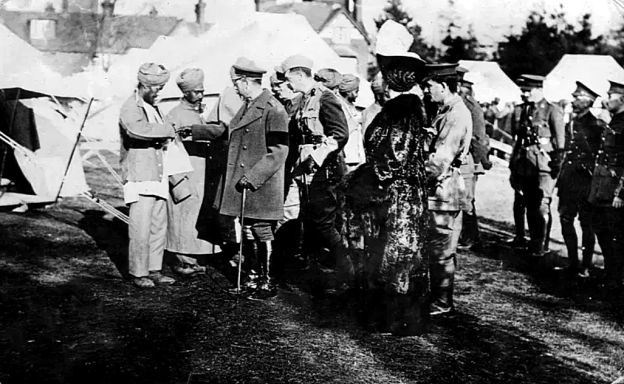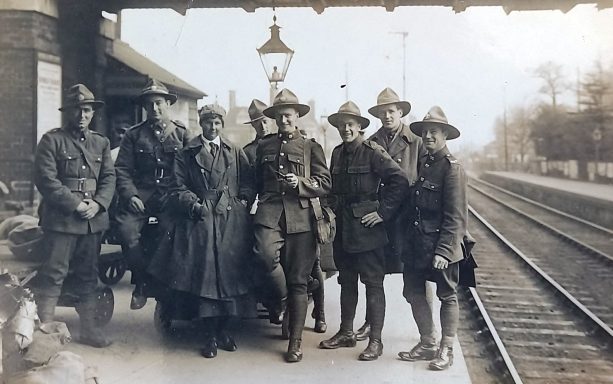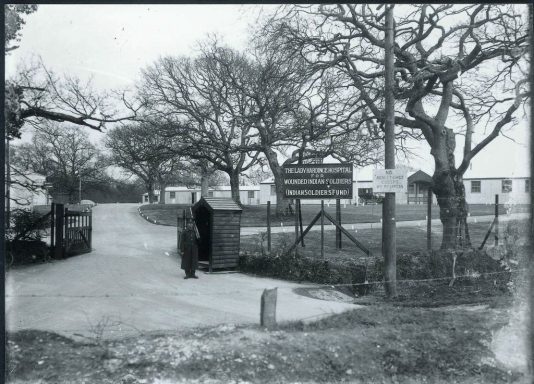Preserving the past and heritage of this wonderful village at the heart of the New Forest
World War One hospitals
Brockenhurst's remarkable role in the First World War
At the start of the First World War (the ‘Great War’) in 1914, Brockenhurst was selected as one of the vast temporary military hospitals established to treat injured service personnel from the battlefront.
Brockenhurst’s railway links to the port of Southampton nearby meant it was ideally situated to receive wounded soldiers for treatment and rehabilitation. From the outbreak of war until the end of 1915 the was home to The Lady Hardinge Hospital for wounded Indian soldiers, treating men from the 3rd (Lahore) and 7th (Meerut) Divisions of the Indian Army Corps. These had been sent to France and Flanders with the British Expeditionary Force.
Lady Hardinge had been married to the then Viceroy of India, Lord Hardinge. She died in 1914. It’s not known who put her name forward for the hospital, but the most likely is HRH Queen Mary, who was Patron of the Committee of the Ladies of the Order of St John of Jerusalem, which initiated the project and gave £10,000 towards the cost of equipment.
The Balmer Lawn and Forest Park hotels were taken over and fitted out as a hospital, with wards, operating theatres and recovery areas. Prefabricated buildings and tents in the grounds provided additional accommodation. Overcrowding quickly became a problem. In 1915 a 520 bed combination of tented and galvanised corrugated iron roofed buildings accommodation units was erected at Tile Barn. Reflecting the roofs, this was known in the village as ‘Tin Town’.
At the end of 1914 HM King George V and HRH Queen Mary visited. They went to the Balmer Lawn and Forest Park hotels, before lunch at Brokenhurst Manor. After lunch they toured nearby Tin Town. The King was especially appreciated by the patients, as he spoke Indian, having been taught as a child.
A visit by some of the hospital’s patrons in March 1915 was reported in The British Journal of Nursing in early 1915: “There are twenty wards in all, of twenty-four beds with the usual annexes, and single wards for native officers, who looked very smart as well as warm in the beautiful dressing-gowns sent by Lady Rothschild… The charge of each sister is 50 beds, 25 in each ward, the two being separated by a corridor. Their duties consist principally of supervision and they have two English orderlies working under them – and there are also native servants. The wards look very bright and trim…”
Three Indian servicemen who died in the hospital are buried in the Commonwealth War Graves Commission cemetery at St Nicholas Church. One was a hospital worker called Sukha. He was low caste, and toiled as a latrine sweeper. After catching an infection, he died in January 1915. But the Islam cemetery in Woking wouldn’t accept the body as he was not of that faith; nor would the Hindu cemetery in Sussex as he was of low caste. So Brockenhurst’s Vicar, Rev. Arthur Chambers organised a collection and erected a headstone in the churchyard in his memory. His epitaph reads that “He left country, home and friends to serve our King and Empire in the Great European War. His earthly life was sacrificed in the interests of others.”
In 1916, the Indian Forces were re-posted to Mesopotamia (Iraq) and Egypt. This made the journey for the injured to Brockenhurst untenable, and new medical facilities were constructed abroad. Some 3,000 Indian soldiers had been treated here.
In turn the hospital transferred to treating New Zealand soldiers wounded in the war. There were several New Zealand medical outposts in England, but Brockenhurst was the No 1 General New Zealand Hospital.
It was staffed and operated by the New Zealand Medical Corps to care for wounded members of the New Zealand Expeditionary Force.
As well as the established medical facilities at Balmer Lawn and Forest Park hotels, other facilities appeared in the village. These included a new ward at the Morant Hall in Lyndhurst Road, and the ‘Kia-Ora Club’ near the village crossroads, where soldiers could recuperate after treatment and staff also relaxed.
The professional staff of doctors and nurses were New Zealanders, and the patients appreciated the ‘home feeling’, But many local women took up roles as auxiliaries. Even the children became involved. Surgeons were aware that the application of Sphagnum Moss after operations helped would to heal and discouraged infection. So school children would set out across the forest with buckets to collect the moss and bring it to the hospital.
Over 21,000 mainly New Zealand casualties were treated at No.1 New Zealand General Hospital between 1916 and its closure at the end of January 1919. 93 New Zealand servicemen died while being treated at Brockenhurst and are buried in the Commonwealth War Graves Commission cemetery at St Nicholas’ Church, Brockenhurst.
Australians and New Zealanders who served and died in conflicts are commemorated annually on 25 April around the world. In Brockenhurst an ANZAC day service is held at the Commonwealth War Graves on the nearest Sunday in April at 3pm. It is always well attended by villagers of all ages, and many visitors from near and far as well as representatives from New Zealand and Australian High Commissions to the UK. In the 1920’s, New Zealand gifted a bell to St Nicholas Church by way of a thank you to the village for its care. At the annual ANZAC service the bell is tolled 93 times to commemorate the memory of each soldier who died here.
Left to right: King George V and Queen Mary visiting Indian patients at the Forest Park hotel, November 1914; New Zealand soldiers arriving at Brockenhurst Station, 1917; the entrance to the No 1 General New Zealand Hospital at Tile Barn, 1918.
© Website copyright David Bennett and Brockenhurst Heritage 2025. All rights reserved.
We need your consent to load the translations
We use a third-party service to translate the website content that may collect data about your activity. Please review the details in the privacy policy and accept the service to view the translations.


